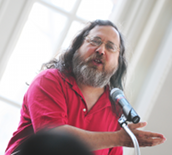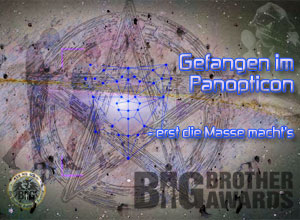

|
search / subscribe / upload / contact |
|
|
||
|
|
||
|
|
||
|
|
||
|
|
||
|
|
||
|
|
||
|
|
||
| RSS-Feed Depeschen | ||

|
||
Date: 2001-08-10
Biometrics: Forschung, Spucke & Unsterblichkeit-.-. --.- -.-. --.- -.-. --.- -.-. --.- -.-. --.- -.-. --.- Technologien, ein anderer Pionier in der Erforschung damals neuer Technologien hieß Edward Teller [H-Bombe]. In den Annalen eines künftigen, gescheiteren Jahrhunderts werden beide als Pioniere der Menschenfeindlichkeit und der Zerstörung verzeichnet sein und ihre Namen werden nicht ausgesprochen werden, sondern ausgespuckt. -.-. --.- -.-. --.- -.-. --.- -.-. --.- -.-. --.- -.-. --.- Iris scans are faster and more accurate than any other computerised means of identifying people, such as fingerprint, face or voice recognition, according to a new study. Most iris recognition systems are based on software created by John Daugman of Cambridge University. An image of an iris, with all the tiny pits, ridges and strings of tissue that make it unique, is turned into a series of three-dimensional contour maps. ... Daugman has now used this system to make 2.3 million random comparisons between images of over 2000 different irises from people in Britain, the US and Japan. The study shows that if two codes match by 75 per cent or more, there's only a one in 1000 billion chance that the match is wrong. With just 12 billion human eyes on the planet, that is quite secure. In another recent trial by the British government, there were no false matches in over two million tests, whereas the failure rate for other methods such as voice recognition ranged from 10 to 25 per cent. And an Eye Ticket Corporation project at an airport in North Carolina has correctly identified half a million volunteers with no mismatches since May last year. Such results prompted the International Air Transport Association to encourage London's Heathrow airport to try using iris scans for ticket and immigration control, in the hope of speeding up check- ins. The scans can be done with a video camera in a few seconds. A pilot project, run by Eye Ticket, will begin in October with a group of frequent travellers who are a low security risk. "Our aim isn't to replace immigration staff, it's to add to it," says Anna Dorricott, a spokeswoman for Britain's immigration department. It is interested in the method, but is waiting for the results of the trial. "We're standing back and just watching." But John Tincey of the Immigration Service Union says that while the scan checks people's identities, it does not assess their intentions. He says it should only ever be used for a select group of people, such as frequent business flyers. Wem noch nicht schlecht ist http://www.newscientist.com/news/news.jsp?id=ns99991125 -.-. --.- -.-. --.- -.-. --.- -.-. --.- -.-. --.- - -.-. --.- -.-. --.- -.-. --.- -.-. --.- -.-. --.- -.-. --.- edited by Harkank published on: 2001-08-10 comments to office@quintessenz.at subscribe Newsletter - -.-. --.- -.-. --.- -.-. --.- -.-. --.- -.-. --.- -.-. --.- |
|
|
|
| CURRENTLY RUNNING | |
q/Talk 1.Juli: The Danger of Software Users Don't Control

|
|
| !WATCH OUT! | |
bits4free 14.Juli 2011: OpenStreetMap Erfinder Steve Coast live in Wien

|
|

